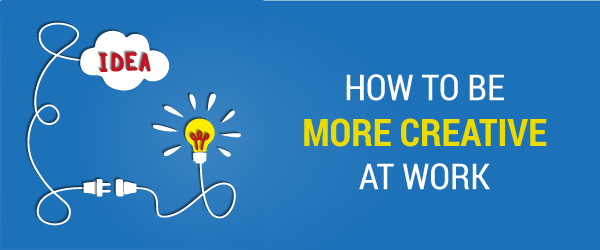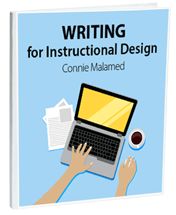
If you continuously come up with compelling and novel ideas at a moment’s notice, you won’t need to read this article. But for the rest of us, there are times when it’s difficult to be creative on demand even though our jobs require it. When you’re working under tight deadlines, feeling stressed from overwork, or situated in a drab environment, it’s easy to get stuck or to feel empty of ideas. This article explains several research-based strategies for ways to be more creative at work.
But first, what is creativity?
People will probably debate the meaning of creativity for the next 100 years. I’m satisfied with this sensible definition of creativity from Clinton and Hokanson (2011), “Creativity is understood to be the generation of ideas that are both novel and useful, usually in response to a problem that needs to be solved.” (I spoke to Brad Hokanson about creativity on Episode 56 of The eLearning Coach Podcast.)
Creativity Can Be Developed
Many psychologists agree that creativity is distributed throughout the population and is not just handed out to a few lucky individuals. Some think that people use less of their natural creative abilities as they mature and become more conventional. Others say that creativity doesn’t wane, but creativity tests aren’t valid for measuring creative thinking and innovation in the real world.
However you think about your own creativity, know that you can develop and enhance these skills. Research shows that in terms of divergent thinking, problem solving, fluency and originality of ideas, performance, and creative attitudes, creativity training appears to be effective (Scott et. al., 2004; Van de Kamp et. al., 2016). What follows are research-based techniques for how to be more creative at work. This includes generating more ideas or increasing flexible and original thinking.
1. Seek Out Ambient Noise for Idea Generation
If you feel more creative when you work at a coffee shop, there is research-based evidence to back you up. A moderate level of ambient noise can improve creativity, when compared to no, low or high levels of ambient noise.
The theory underlying this phenomenon is that moderate ambient noise is distracting. This causes some difficulty processing information (known as disfluency). When mental processing is made somewhat more difficult, it induces a higher level of abstract thinking, which can enhance creativity.
On the other hand, a low amount of ambient noise does not cause sufficient distraction to disrupt processing and induce abstract thinking. And a high level of ambient noise causes so much distraction it reduces the extent of information processing and impairs creativity. So yes, you can use this research for permission to work in a nearby coffee shop (Mehta et al., 2012).
2. Widen Your Sphere of Information
Psychologists refer to the range of information and events (stimuli) that a person attends to at one time as their “breadth of attention.” Research shows that finding creative and effective solutions to complex problems is more likely when you widen your breadth of attention than when you narrow it.
A wider sphere of information allows you to associate more varied stimuli that you may not pay attention to because it seems irrelevant. When you simultaneously focus on many elements, your mind is more likely to combine this information into unique and original ideas (Memmert, 2007).
3. Create Hierarchical Lists
This little known method could be just what you need to generate lots of unique solutions to a problem—the Hierarchical Heuristic. Start out by creating an initial list of solutions. Analyze this list to find the solutions that have something in common. The commonality becomes the general category of solutions, known as the superordinate. Then find additional solutions that are examples or subordinate to your superordinate.
Continue in this way to find new categories of solutions and again generate subordinate examples for your new category. This approach has been shown to facilitate the generation of many high quality solutions (Butler and Thomas, 1999).
4. Move, Walk, Get Out of Your Chair
Multiple experiments show that some form of body movement—away from a chair—can enhance creativity. Your physical activity can be as simple as pacing around a room or as energetic as walking outdoors. The idea is that body movement helps you overcome fixated thinking (Leung et al., 2011). For some of us, it’s confining to be constricted to a chair while trying to generate new solutions.
Interestingly, one experiment showed that adults and children improved their cognitive performance when they walked at their naturally preferred speed rather than walking at at a fixed speed—as on a treadmill. These researchers theorize that physical activity provides more energy, which can be invested in renewed mental resources (Schaefer et al., 2010).
5. Enhance Sharing and Social Interactions
If you can influence your work environment, promote a more social atmosphere. Research suggests that creativity improves when a person’s work environment breaks through traditional silos to become an adhocracy. Wikipedia defines that as”an organization that cuts across normal bureaucratic lines to capture opportunities, solve problems, and get results (Wikipedia).”
Other social factors that enhance workplace creativity include high levels of employee participation and knowledge sharing. Generally, high employee participation can enhance innovation. This includes employees setting goals, making decisions and appraising results. Knowledge sharing gives employees exposure to varied ideas, important feedback and social interaction, all of which enhance creativity at work (Schepers & van den Berg, 2007).
6. Think from different perspectives: Six Thinking Hats
Many people are familiar with the Six Thinking Hats technique, but in case you’re not, consider trying this strategy. The purpose is to examine a problem from six different perspectives. This should provide a rich collection of insights. You can find more details of this technique at Six Thinking Hats, so this will be brief.
- Blue hat: Manages the Six Thinking Hats process.
- Green hat: Focuses on creative exploration and possibilities.
- Red hat: Signifies emotion and calls on your intuitive perspective.
- Yellow hat:Represents positivity, where you focus on value and benefits.
- Black hat: Uses critical judgment to explore the risk management aspect of the problem.
- White hat: Seeks factual information.
Resources for Improving Creativity
- How to Develop Your Creativity (Listen or download the transcript)
- Seven Books to Boost Your Creativity
- A Creativity-friendly Instructional Design Model
- Is Your Creativity Blocked?
- Too Much or Too Little Noise Turns Off Consumers, Creativity
References:
- Butler, D.L. & M. Klein (1998). Good Versus Creative Solutions: A Comparison of Brainstorming, Hierarchical, and Perspective Changing Heuristics, Creativity Research Journal, Vol. 11, No. 4, 325-331.
- Clinton, G. & B. Hokanson (2011). Creativity in the training and practice of instructional designers: the Design/Creativity Loops Model. Educational Technology Research and Development, 60:111–130.
- Leung, A. et al., Embodied Metaphors and Creative “Acts” (2011). Cornell University ILR Collection.
- Mehta, R., Zhu, R., & Cheema, A. (2012). Is Noise Always Bad? Exploring the Effects of Ambient Noise on Creative Cognition. Journal of Consumer Research, electronically published March 21, 2012.
- Memmert, Daniel (2007). Can Creativity Be Improved by an Attention-Broadening Training Program An Exploratory Study Focusing on Team Sports, Creativity Research Journal: Vol. 19, Nos. 2–3: 281–291.
- Nair, K.D. & R. Gopal (2011). Advocating Different Paradigms: Relevance of Workplace Creativity. SIES Journal of Management, Vol.7 No.2: 142-150.
- Schaefer, S., Lövdén, M., Wieckhorst, B., & Lindenberger, U. (2010). Cognitive performance is improved while walking: Differences in cognitive–sensorimotor couplings between children and young adults. European Journal of Developmental Psychology: Volume 7, Issue 3.
- Schepers, P. & van den Berg, P.T. (2007). Social Factors of Work-Environment Creativity, Journal of Business and Psychology, Vol. 21, No. 3, pp. 407-428.
- Scott, G., Leritz, L. E. and Mumford, M. D. (2004). The Effectiveness of Creativity Training: A Quantitative Review. Creativity Research Journal, Vol. 16, No. 4, 361–388.
- Van de Kamp, M., Admiraal, W. & G. Rijlaarsdam (2016). Becoming original: effects of strategy instruction. Instructional Science 44:543–566.


thanx Connie this is wonderful,, these points work out really well.. especially 1, 3 and 4.
Hi Ginger,
Thanks for adding your perspective to the conversation. I respect your views. In terms of the ambient noise study, I love that one because it works for me! And yes, no one technique will work for everyone. I didn’t mean to imply that. You have to try out the many approaches or come up with your own, until you find success. Hope to hear from you again.
Best,
Connie
Sorry, Connie, but I am highly sceptical of many of these studies; and research-based doesn’t mean that they are scientifically conclusive. I think creativity can be stimulated in many ways, and I don’t think some of the suggested techniques are bona fide ways to get creative juices flowing in all people. I think they may work for some, not for others. I think the last one–high levels of participation and knowledge sharing, for example–just seems to play into the idea that collaboration and team work are always good for creativity. I don’t buy it, no matter what corporate coaches may say. I think breakthough thinking can just as easily be diluted, dulled, or dismissed by a group, due to its very originality and seeming strangeness. Creativity is often highly disruptive and disturbing, uncomfortable…And the ambient noise level study example just seems goofy to me!
Jay,
That’s fascinating. Thanks for adding to the list. Anyone else?
Connie
Connie, wait, wait, there’s more.
People who have well-being in their lives have three times the number of creative flashes as their peers according to a meta-study of 255 research projects reported by Shawn Achor at Harvard.
http://www.scoop.it/t/well-being
*** Excellent point! 😉 ***
Hey Judy — You’re instincts are always right, aren’t they?
Connie
Good list! And it has confirmed my instincts that taking short walks at work and reshaping my workspace to facilitate better collaboration with my coworkers are good moves. Woot!